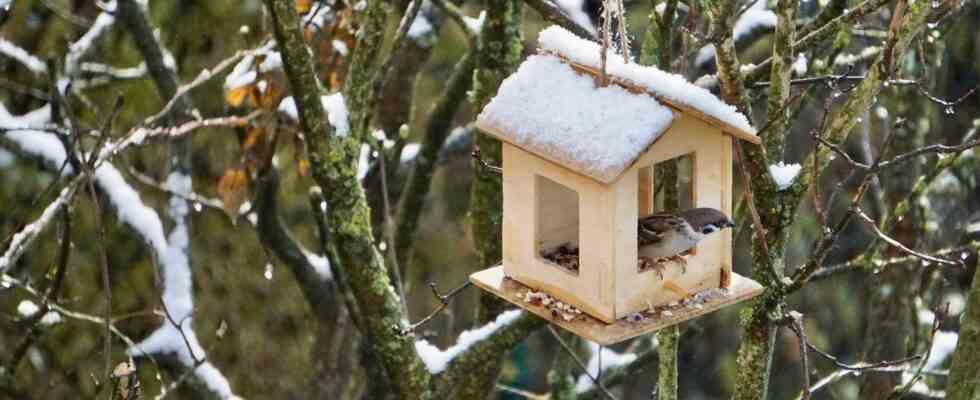garden tips
Protecting plants, supporting animals: What pipits can do for good in December
The garden year is finally on the home stretch. This work is still pending in December.
© Liudmila Kiermeier / Getty Images
Instead of shopping for Christmas presents, plant and garden lovers have to work hard again in December. But in the broadest sense, they also distribute gifts. What are they and how to properly protect plants from frosty nights? Find out here.
Hibernation has returned to most of the many hundreds of allotment garden colonies between North Friesland and Lake Constance. The arbors were winterized. The rain barrels have been emptied. The last winter vegetables have been harvested. But there is always something to do in the garden and front yard. That’s not much in December. Allotment gardeners can do something good for this. For their plants and for domestic animals that cannot sit in the heated living room in winter or warm their legs by the fireplace. In the following article you will find out how you can protect potted plants and the like from freezing, help garden birds with their foraging for food and prepare the greenhouse for frosty nights.
1. Clean greenhouse
Greenhouses are a fine thing. Especially in winter and especially when they can be heated. But heat alone is not enough to make the “residents” happy. Because frost-sensitive potted plants and exotic plants need not only appropriate temperatures but also light to survive. Therefore, the plastic or glass covering should be thoroughly cleaned once on a frost-free day in December. An ordinary one is sufficient for this hand washing brush, which is ideally connected to a water hose. If the temperature falls below freezing, however, the plants in the greenhouse have a different problem. The solution for this are so-called frost monitors (e.g. the Frosty by Bio Green). They have a built-in thermostat that turns on the outdoor heater at a temperature of your choice and protects the plants from freezing. You can find more practical tips in the book, for example “The small greenhouse: technology and use”.
2. Support birds and other animals
In the cold season, especially in cities, birds and other domestic animals are increasingly lacking not only places to retreat, but above all sources of food. In allotment colonies, tits, sparrows and the like will find both at best. True to the motto: if you don’t spend time in the garden yourself in December, at least make it as pleasant as possible for the feathered visitors.
That classic birdhouses is a perennial favorite. It not only offers a roof over your head, but also serves as a feeding bowl for hungry guests at a dizzy height. Important: Even birds have different tastes and preferences. Tits, sparrows and finches prefer grain feed, while robins, thrushes and blackbirds prefer soft food such as worms, apples or raisins. So if you want to help many species feed, spread as widely as possible. Not covered, but definitely a culinary alternative to the birdhouse fat balls or rings. You can buy them ready-made or you can make them yourself with the children.
Important: Kitchen waste has no place in the bird house!
In addition to the birds, two quadrupeds are also happy about additional food donations. Squirrels in particular are faced with major challenges in frosty temperatures or even snow. The red-brown climbing artists then find it difficult to access their laboriously collected and bunkered supply. Hazelnuts, walnuts, sunflower seeds, pieces of apple and carrots are among the favorites on the squirrel menu. A small drinking trough with fresh water is also well received by the nimble small mammals. They can also share it with their feathered fellow sufferers on the balcony or terrace. Here’s one Wildlife Friend modelwhich can be attached to the balcony parapet.
3. Protect plants from frost
Allotment gardeners have to go out again at the latest when the outdoor thermometer approaches zero degrees. Because potted plants, roses and other ornamental plants have to get through the frosty days and nights without a hat or scarf. But there are a few other options to protect plants from frost damage. In addition to so-called winter protection or winter tents are these coconut mats, antifreeze fleece and foil tunnel. With the exception of the coconut mats, all variants are translucent, so that the packed plants can continue to photosynthesize with the little light during the short days and survive the winter. In addition, the materials must water and air permeable be, because waterlogging and condensation are poison for the plants. In small tents and under frost protection fleece, particularly hardy potted plants feel at home. However, young plants that have already been planted and frost-sensitive shrubs can also be wrapped in the thin fleece made of light-weight plastic. A good alternative are jute blankets. They are also permeable to light and air and can be used as a roof for a temporary winter tent with the help of branches.
For plants that need little or no light in winter, coconut mats are a good option. They are a bit more expensive, but much more durable than anti-freeze fleece. Basically, coconut or hemp mats are suitable for wrapping small and larger planters to protect soil and roots from frost.
Sources:NABU
You might also be interested in:
This article contains so-called affiliate links. There is more information here.


